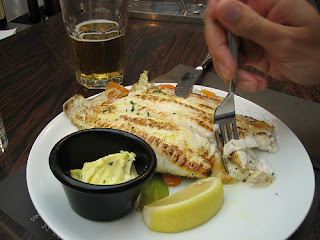from
Behind the French Menu
by
Bryan G. Newman
behindthefrenchmenu@gmail.com
European Plaice.
https://www.flickr.com/photos/biodivlibrary/10574144975/
Plaice on the menu.
Carrelet, Plie or Plie d'Europe – Plaice, European Plaice is a sea-fish with delicate flesh that often replaces the more expensive and better textured, and more expensive, Dover sole. Plaice will be on restaurant menus as filets as they are mostly caught when quite large though they may be baked whole and then fileted. In Normandy and Brittany, so famous for their sea fish and seafood plaice is often on the menu with recipes that include their local cider. In the UK plaice filets may be on sale at the local fish and chip shop.
Plaice and chips on sale in the UK.
Plaice is not a flounder though there is a family connection.
When you see a whole plaice, you will recognize it from its oval/diamond shape and the orange or red spots on its gray back. The underside is white. N.B. American plaice is a slightly different fish from that served in Europe, but it is from the same family, a tasty fish with tender but less firm flesh than the European plaice.
The plaice that reaches the tables in France come from the Mediterranean, the English Channel and the Northeast Atlantic, with most fish caught weighing between 2 and 3 kilos though larger fish occasionally do get caught. Some fish may be caught by amateur fishermen and fisherwomen, but most will have been caught by the large fishing vessels. Some plaice will be delivered to the fish wholesalers as whole fish and others as prepared fillets.
.
Plaice on French Menus:
Carrelet Grillé à la Plancha et son Beurre Citronné – Carrelet grilled on a plancha flavored with a warm lemon flavored butter sauce.
Filet de Carrelet Beurre Blanc au Cidre, Riz et Ratatouille Maison - A filet of plaice prepared with a beurre blanc sauce using cider instead of white wine and served with rice and the restaurant’s take on Ratatouille.
A roasted filet of plaice.
Photograph courtesy of Hotel Le Plaza, Brussels
Filet de Carrelet Grillé avec Fenouil, Mousseline de Pommes de Terre et Sauce Hollandaise – Filet of grilled plaice flavored with fennel and served with a potato moose and Hollandaise Sauce.
Roulade de Carrelet, Crème de Crevettes Grises – A filet of plaice rolled around a cream of sand shrimps.
Fish (plaice) and chips
With mushy peas and sauce tartare on the side.
Filet de Plie, Aubergines Confites, Persillade, Sauce Vierge – Filet of plaice served with aubergines confits, cooked to a consistency of a jam, a persillade sauce of garlic and parsley and a sauce vierge.
A Sauce Vierge translates as a virgin sauce. The name comes from the use of virgin olive oil. Sauce Vierge will most usually be on your menu with fish dishes. As its name suggests, it includes virgin olive oil and with the oil will be fresh tomatoes, garlic, lemon juice, basil, red wine vinegar, salt and black pepper. The sauce will be served slightly warm but not cooked as virgin olive oil quickly loses flavor when cooked. The sauce will be poured on the fish just before it is served.
Grilled plaice and Sauce Tartare.
Filet de Plie aux Queues d'Écrevisses et Sauce Américaine – Filet of Plaice served with freshwater crayfish tails. The original Sauce Américaine (or Sauce Armoricaine) was created for the homard, the two-clawed European lobster. Today; however, the European two-clawed lobster will be too expensive for most restaurants’ clientele, and many chefs will use the langouste, the clawless rock lobster, the owner of the lobster tail or, as in this case, freshwater crayfish tails.
Sauce Américaine is a popular sauce made with butter, olive oil, white wine, cognac, garlic, tomatoes, onions, shallots, herbs. Chefs will seek out alternatives for the lobster coral, the lobster’s roe, and the lobster’s liver that were an essential part of the original recipe for a Sauce Américaine. For more detail about the arguments over the correct name for this sauce and the influences behind the sauce’s creation click here.
Plaice on sale in a market.
Rougail de Filet de Plie aux Bananes Plantin Rôties et Gratin de Cristophine à l'Emmental - A French Rougail Creole stew of herbs and spices prepared with the plaice, grilled plantains, cooking bananas, and mashed Cristophines browned under the grill with Emmental cheese.
The Christophine, named after Christopher Columbus, is a pale green to whitish vegetable that originated in Mexico. In the Caribbean, the Christophine is an important vegetable, mostly called the chouchou, it is often cooked like mashed potatoes and here it is browned under the grill with Emmental cheese.
Rougail is a herb, spice, and vegetable grouping that comes from French Creole cuisine in the Indian Ocean. The ingredients, often prepare as a stew will include ginger, thyme, pimiento, and tomatoes. Sometimes garlic and onions will be added along with white wine.
Filet Frit de Plie
Fried filet of plaice.
Served with a beef sausage creamed wild spinach and star anis sauce
(Catalan - palaia anglesa), (Dutch - schol), (German – scholle) (Italian – passera or solla), (Spanish - solla, solla europea).
Connected Posts:
Ratatouille, the essence of Provencal cuisine and Ratatouille’s Ancestor, the Bohémienne de Légumes.
Copyright 2010, 2017.








No comments:
Post a Comment